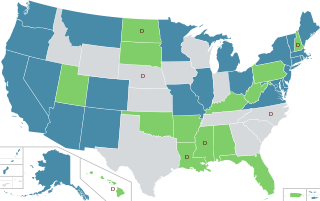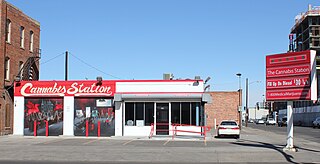
The legality of cannabis for medical and recreational use varies by country, in terms of its possession, distribution, and cultivation, and how it can be consumed and what medical conditions it can be used for. These policies in most countries are regulated by three United Nations treaties: the 1961 Single Convention on Narcotic Drugs, the 1971 Convention on Psychotropic Substances, and the 1988 Convention Against Illicit Traffic in Narcotic Drugs and Psychotropic Substances. Since its descheduling in 2020, cannabis is classified as a Schedule I drug under the Single Convention treaty, meaning that signatories can allow medical use but that it is considered to be an addictive drug with a serious risk of abuse.

In the United States, the removal of cannabis from Schedule I of the Controlled Substances Act is a proposed legal and administrative change in cannabis-related law at the federal level. It has been proposed repeatedly since 1972. The category is the most tightly restricted category reserved for drugs that have "no currently accepted medical use."

In the United States, increased restrictions and labeling of cannabis as a poison began in many states from 1906 onward, and outright prohibitions began in the 1920s. By the mid-1930s cannabis was regulated as a drug in every state, including 35 states that adopted the Uniform State Narcotic Drug Act. The first national regulation was the Marihuana Tax Act of 1937.

Drug liberalization is a drug policy process of decriminalizing or legalizing the use or sale of prohibited drugs. Variations of drug liberalization include: drug legalization, drug re-legalization and drug decriminalization. Proponents of drug liberalization may favor a regulatory regime for the production, marketing, and distribution of some or all currently illegal drugs in a manner analogous to that for alcohol, caffeine and tobacco.

The use, sale, and possession of cannabis containing over 0.3% THC by dry weight in the United States, despite laws in many states permitting it under various circumstances, is illegal under federal law. As a Schedule I drug under the federal Controlled Substances Act (CSA) of 1970, cannabis containing over 0.3% THC by dry weight is considered to have "no accepted medical use" and a high potential for abuse and physical or psychological dependence. Cannabis use is illegal for any reason, with the exception of FDA-approved research programs. However, individual states have enacted legislation permitting exemptions for various uses, including medical, industrial, and recreational use.

In the United States, the use of cannabis for medical purposes is legal in 38 states, four out of five permanently inhabited U.S. territories, and the District of Columbia, as of March 2023. Ten other states have more restrictive laws limiting THC content, for the purpose of allowing access to products that are rich in cannabidiol (CBD), a non-psychoactive component of cannabis. There is significant variation in medical cannabis laws from state to state, including how it is produced and distributed, how it can be consumed, and what medical conditions it can be used for.
Marc-Boris St-Maurice is an activist, politician and Canadian musician, who has campaigned for many years for the legalization of cannabis, and to facilitate access to the drug for health reasons. He lives in Montreal, Quebec.
Wo/Men's Alliance for Medical Marijuana (WAMM) is a not-for-profit medicinal cannabis dispensing collective located in Santa Cruz, California. WAMM was founded in 1993 by Valerie Leveroni Corral and her then-husband Michael Corral. Valerie Corral is also the executive director of Raha Kudo: Design for Dying Project, a non-profit corporation that provides education and research to support persons facing death and their caregivers. Members of WAMM receive organic medicinal cannabis at cost while volunteers trade work for cannabis. There is a compassion program for those unable to afford the full cost of medical cannabis. WAMM was the first medical marijuana collective to receive non-profit status from the United States Government.

The Access to Cannabis for Medical Purposes Regulations (ACMPR) are a set of Canadian regulations enacted by Health Canada in August 2016 concerning the production, distribution, personal cultivation and use of medical cannabis.

Cannabis in Puerto Rico is illegal for recreational use. Legislation to ban cannabis was passed in 1932, and legislation to legalize medical use was passed in 2017. Although the medical use of cannabis is permitted, smoking it is prohibited.

Cannabis in Michigan is legal for recreational use. A 2018 initiative to legalize recreational use passed with 56% of the vote. State-licensed sales of recreational cannabis began in December 2019.
The list includes and details significant events that occurred in the global history of national-level implementations of, or changes made to, laws surrounding the use, sale, or production of the psychoactive drug cannabis.

The Cannabis Act (C-45) of June, 2018 paved the way for the legalization of cannabis in Canada on 17 October 2018. Police and prosecution services in all Canadian jurisdictions are currently capable of pursuing criminal charges for cannabis marketing without a licence issued by Health Canada. The Supreme Court of Canada has held that the federal Parliament has the power to criminalize the possession of cannabis and that doing so does not infringe upon the Canadian Charter of Rights and Freedoms. The Ontario Court of Appeal and the Superior Court of Ontario have, however, held that the absence of a statutory provision for medical marijuana is unconstitutional, and to that extent the federal law is of no force and/or effect if a prescription is obtained. The recreational use of cannabis has been legalized by the federal government, and took effect on 17 October 2018.

Cannabis in Quebec became legal when the national Cannabis Act went into force on 17 October 2018. Cannabis in Canada has been legal for medicinal purposes since 2001 under conditions outlined in the Marihuana for Medical Purposes Regulations, later superseded by the Access to Cannabis for Medical Purposes Regulations, issued by Health Canada and seed, grain, and fibre production was permitted under licence by Health Canada.

Cannabis in Prince Edward Island became legal when the national Cannabis Act went into force on October 17, 2018.

Cannabis in Newfoundland and Labrador became legal when the national Cannabis Act went into force on October 17, 2018.
Cannabis in Yukon became legal when the national Cannabis Act went into force on October 17, 2018.

Cannabis in Saskatchewan became legal when the national Cannabis Act went into force on 17 October 2018.

Cannabis in the Northwest Territories became legal when the national Cannabis Act went into force on 17 October 2018.

The Green Rush (2012–present) is an ongoing global economic event that began on December 6, 2012, when cannabis was legalized in the US state of Washington; Colorado's legalization took effect four days later. While still illegal federally in the United States, the actions of these two state governments signaled the opening of a market projected to be worth US$48+ billion globally by 2027. As of 2019 the cannabis industry had created over 250,000 jobs. However, cannabis companies have been a mixed investment success, with many experiencing plunging stock prices, massive layoffs, and failure to meet investor expectations.